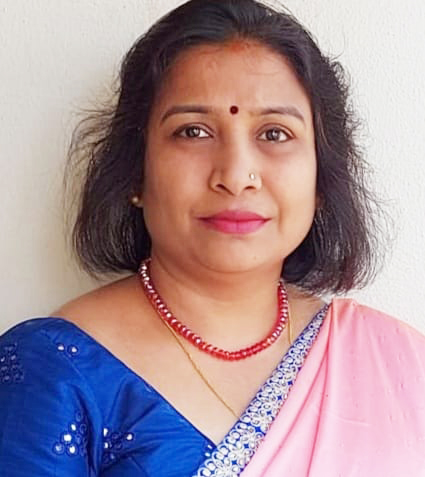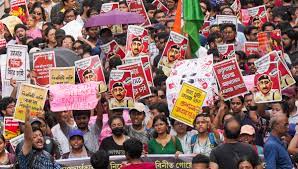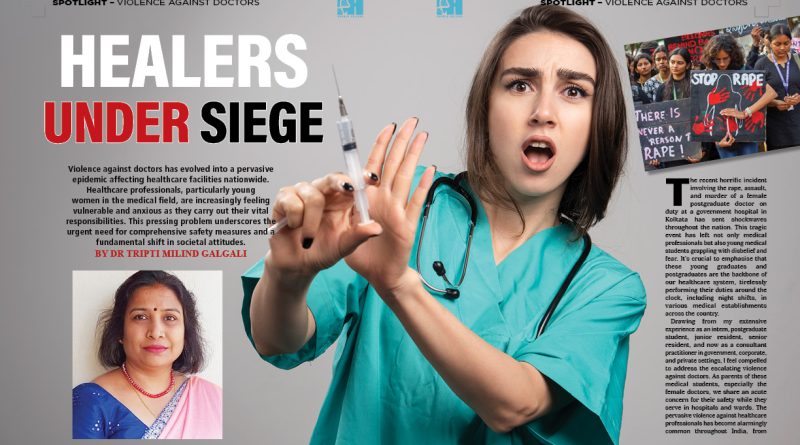Healers Under Siege
 Violence against doctors has evolved into a pervasive epidemic affecting healthcare facilities nationwide. Healthcare professionals, particularly young women in the medical field, are increasingly feeling vulnerable and anxious as they carry out their vital responsibilities. This pressing problem underscores the urgent need for comprehensive safety measures and a fundamental shift in societal attitudes.
Violence against doctors has evolved into a pervasive epidemic affecting healthcare facilities nationwide. Healthcare professionals, particularly young women in the medical field, are increasingly feeling vulnerable and anxious as they carry out their vital responsibilities. This pressing problem underscores the urgent need for comprehensive safety measures and a fundamental shift in societal attitudes.
By Dr Tripti Milind Galgali
The recent horrific incident involving the rape, assault, and murder of a female postgraduate doctor on duty at a government hospital in Kolkata has sent shockwaves throughout the nation. This tragic event has left not only medical professionals but also young medical students grappling with disbelief and fear. It’s crucial to emphasise that these young graduates and postgraduates are the backbone of our healthcare system, tirelessly performing their duties around the clock, including night shifts, in various medical establishments across the country.
Drawing from my extensive experience as an intern, postgraduate student, junior resident, senior resident, and now as a consultant practitioner in government, corporate, and private settings, I feel compelled to address the escalating violence against doctors. As parents of these medical students, especially the female doctors, we share an acute concern for their safety while they serve in hospitals and wards. The pervasive violence against healthcare professionals has become alarmingly common throughout India, from villages and small towns to major metropolitan areas. Doctors are increasingly facing attacks from patients and their relatives.

The most vulnerable environments—emergency wards, casualty units, ICUs, and trauma centres—are frequently hotspots for mob violence and vandalism. The alarming frequency, with which young doctors suffer grievous injuries or, in some tragic instances, succumb to physical assaults, raises a grave concern within the medical community. This environment not only inflicts physical harm but also contributes significantly to mental health issues such as stress, depression, anxiety, and, tragically, even suicides among healthcare workers, particularly the younger ones. Although the Government of India has introduced protective legislation, such as the Epidemic Diseases (Amendment) Act 2020, which mandates penalties for violence against healthcare professionals, the reality is often starkly different. In many cases, the perpetrators of mob violence manage to evade justice, receiving only warnings or minimal consequences.
A significant shortcoming in many Indian hospitals is the lack of separate duty rooms for female doctors. Even when such facilities exist, they often lack adequate security features, such as latches, making them easily accessible. The lighting in these areas is frequently inadequate or entirely missing, creating an unsafe atmosphere. Additionally, security personnel assigned to these floors are often either absent or, when present, are not in a state to provide effective protection. Female doctors frequently find themselves sharing changing rooms, washrooms, and restrooms with nursing and housekeeping staff for security reasons.
While some authorities attribute these safety issues to a lack of funding in government facilities, it is evident that private hospitals and corporate settings offer comparatively better conditions. Nonetheless, across all sectors, emergency, casualty, and trauma units fall short in providing a safe and healthy environment for healthcare professionals, especially women. The primary concern remains the ease with which anyone can access hospital facilities, juxtaposed against the considerable challenges faced when seeking immediate assistance.
Compounding these issues is the weak mobile network coverage in critical areas such as ICUs, operating theatres, and emergency wards. These closed environments often hinder reliable internet access, making it exceedingly difficult to call for immediate help during an attack. The pressing question remains: how can we effectively safeguard our doctors? How can we ensure that these dedicated healing hands are protected from assaults, harassment, and violence?

In my practice, we implemented several protocols aimed at ensuring the safety of female doctors during night shifts in emergency situations. Female doctors on call were required to move in groups of two or three, ideally accompanied by a male colleague, never venturing alone. Effective communication was paramount; we maintained constant updates regarding movements and patient conditions to the main Intensive Care Unit (ICU), where a supervisor was always present to monitor any signs of distress.
Moreover, we ensured that CCTV cameras in corridors were operational, particularly in emergency, casualty, and trauma areas. Security personnel were tasked with restricting the presence of large crowds accompanying patients, which often exacerbated security risks. However, controlling mob violence in government hospitals, where foot traffic is high, presents a significant challenge. Screening every individual entering the hospital is a daunting, if not impossible, task.
In high-risk areas such as emergency and trauma care, where complex cases often result in high mortality rates, it is imperative that security measures be not only efficient but also tactfully executed. Institutional heads and department leaders must establish stringent protocols and take full responsibility for the safety of all medical staff, regardless of gender. This includes implementing rigorous biometric screening for departments and duty rooms, providing separate restrooms for female doctors, and ensuring well-lit corridors with functional CCTV surveillance.
These workplace safety guidelines should be universally applicable across all sectors where female employees are required to work night shifts. I earnestly urge the government, lawmakers, and law enforcement agencies to come together to enhance the protection of doctors in their workplaces. There must be strict repercussions for those who violate these protections. The safety of all healthcare providers—male and female, nurses, and paramedics—must be prioritised to ensure a secure working environment. This is a fundamental right for every healthcare professional in our nation.
While it is crucial to establish strict protocols for safety, we must also recognise that societal attitudes toward doctors and, particularly, female professionals, must evolve. Authorities must guarantee safe workplaces, but women, too, should remain vigilant and take measures to protect themselves—be it through self-defence training, carrying pepper spray or tasers, or maintaining a heightened awareness of their surroundings.

Unless societal mindsets shift, the cycle of violence against healthcare professionals will persist, akin to an epidemic. In response to the recent horrific crime against the female doctor, medical professionals across India are uniting in protest, calling for a nationwide strike. Some non-medical observers question why the government and judiciary seem to focus exclusively on the protection of female doctors, arguing that all working women deserve protection.
It is essential to recognise that doctors often face unpredictable and emotionally charged situations involving patients and their families. Such encounters can lead to heightened tensions and aggressive behaviours that are both unexpected and unprepared for. Therefore, it is imperative that we protect our healthcare providers, allowing their compassionate hands to continue saving lives without the looming fear of violence.
To every female doctor and every woman leaving home for work, your safety is paramount. The time for change is now.
(The author is well known Anaesthesiologist in the Department of Emergency Care and Intensive Care, Casualty, and Trauma Care Units, Hubli, Karnataka.)

